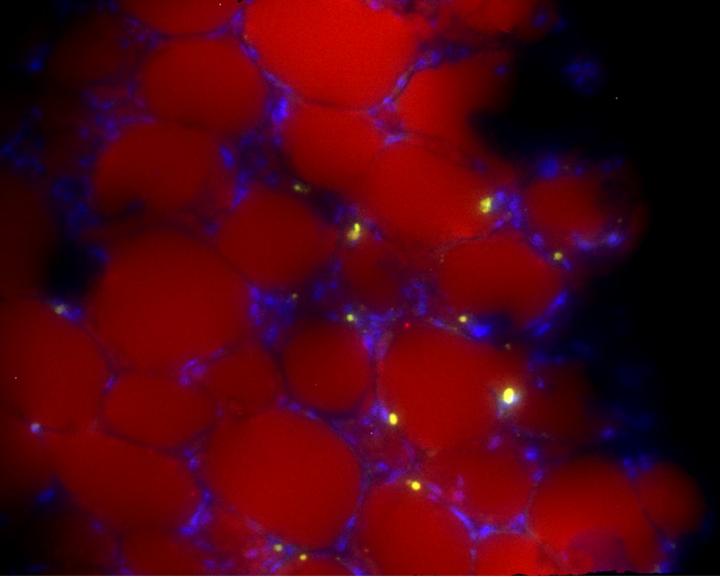Standard BMI inadequate for tracking obesity during leukemia therapy

Leukemia cells (yellow) are shown dispersed among fat cells (red) and surrounded by supportive cells (blue). Credit: Children's Hospital Los Angeles
Acute lymphoblastic leukemia (ALL) is the most common cancer of childhood. In previous work done at CHLA, investigators reported that obese children diagnosed with high-risk ALL had a 50% greater risk of their disease recurring compared with children who were not obese.
“In my lab we've seen a direct interaction between fat cells and leukemia cells that may help explain this increased risk of disease relapse,” said Steven Mittelman, MD, PhD, director of the Diabetes and Obesity program at CHLA and senior author on the study.
“It appears that the fat cells “protect” leukemia cells, making them less susceptible to chemotherapy – and making an accurate measure of body fat essential.” Mittelman is also an associate professor of Pediatrics and Physiology and Biophysics at the Keck School of Medicine of USC.
Typically, BMI is used to estimate body fat and determine obesity. Since BMI is calculated from height and weight measurements, it does not differentiate between fat and muscle tissue. So increases in body fat with concurrent loss of lean muscle could result in an unchanged BMI, and an inaccurate estimation of body composition.
To determine if BMI accurately reflects body fat in this population, 50 patients, predominantly Hispanic between the ages of 10 to 21 years with newly diagnosed high-risk B-precursor ALL or T-cell ALL prospectively enrolled in this trial.
Percentage of total body fat and lean muscle mass was measured directly, using the gold standard of dual-energy X-ray absorptiometry (DXA) at time of diagnosis, one month later, and later during chemotherapy treatment. BMI z-score – a measure of how a given child's BMI deviates from a population of children of the same age and sex – was also determined at these time points.
“We found that change in BMI did not reflect changes in body fat or obesity,” said Etan Orgel, MD, first author on the study and an attending physician in the Survivorship & Supportive Care Program at the Children's Center for Cancer and Blood Diseases at CHLA. “In some patients, reaching a “healthy” BMI was due solely to loss of muscle even while body fat continued to rise. Based on these results, we believe that evaluation of obesity in patients with leukemia should include direct measures of body composition.”
Additional contributors to the study include Nicole M. Mueske, Richard Sposto, Vicente Gilsanz and David Freyer, all of Children's Hospital Los Angeles. Funding was provided in part by the National Center for Advancing Translational Sciences/NIH (UL1TR000130), the Leukemia and Lymphoma Society (LLS-6249-11), Hyundai Hope on Wheels Foundation, and The Saban Research Institute.
About Children's Hospital Los Angeles
Children's Hospital Los Angeles has been named the best children's hospital in California and among the top 10 in the nation for clinical excellence with its selection to the prestigious U.S. News & World Report Honor Roll. Children's Hospital is home to The Saban Research Institute, one of the largest and most productive pediatric research facilities in the United States. Children's Hospital is also one of America's premier teaching hospitals through its affiliation since 1932 with the Keck School of Medicine of the University of Southern California. For more information, visit CHLA.org. Follow us on Twitter, Facebook, YouTube and LinkedIn, or visit our blog at http://researchlablog.
Media Contact
All latest news from the category: Interdisciplinary Research
News and developments from the field of interdisciplinary research.
Among other topics, you can find stimulating reports and articles related to microsystems, emotions research, futures research and stratospheric research.
Newest articles

Superradiant atoms could push the boundaries of how precisely time can be measured
Superradiant atoms can help us measure time more precisely than ever. In a new study, researchers from the University of Copenhagen present a new method for measuring the time interval,…

Ion thermoelectric conversion devices for near room temperature
The electrode sheet of the thermoelectric device consists of ionic hydrogel, which is sandwiched between the electrodes to form, and the Prussian blue on the electrode undergoes a redox reaction…

Zap Energy achieves 37-million-degree temperatures in a compact device
New publication reports record electron temperatures for a small-scale, sheared-flow-stabilized Z-pinch fusion device. In the nine decades since humans first produced fusion reactions, only a few fusion technologies have demonstrated…





















